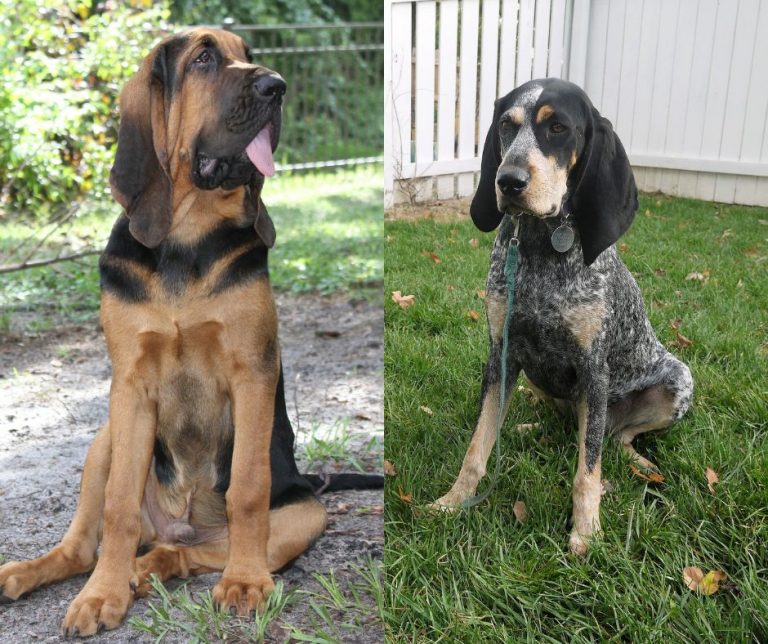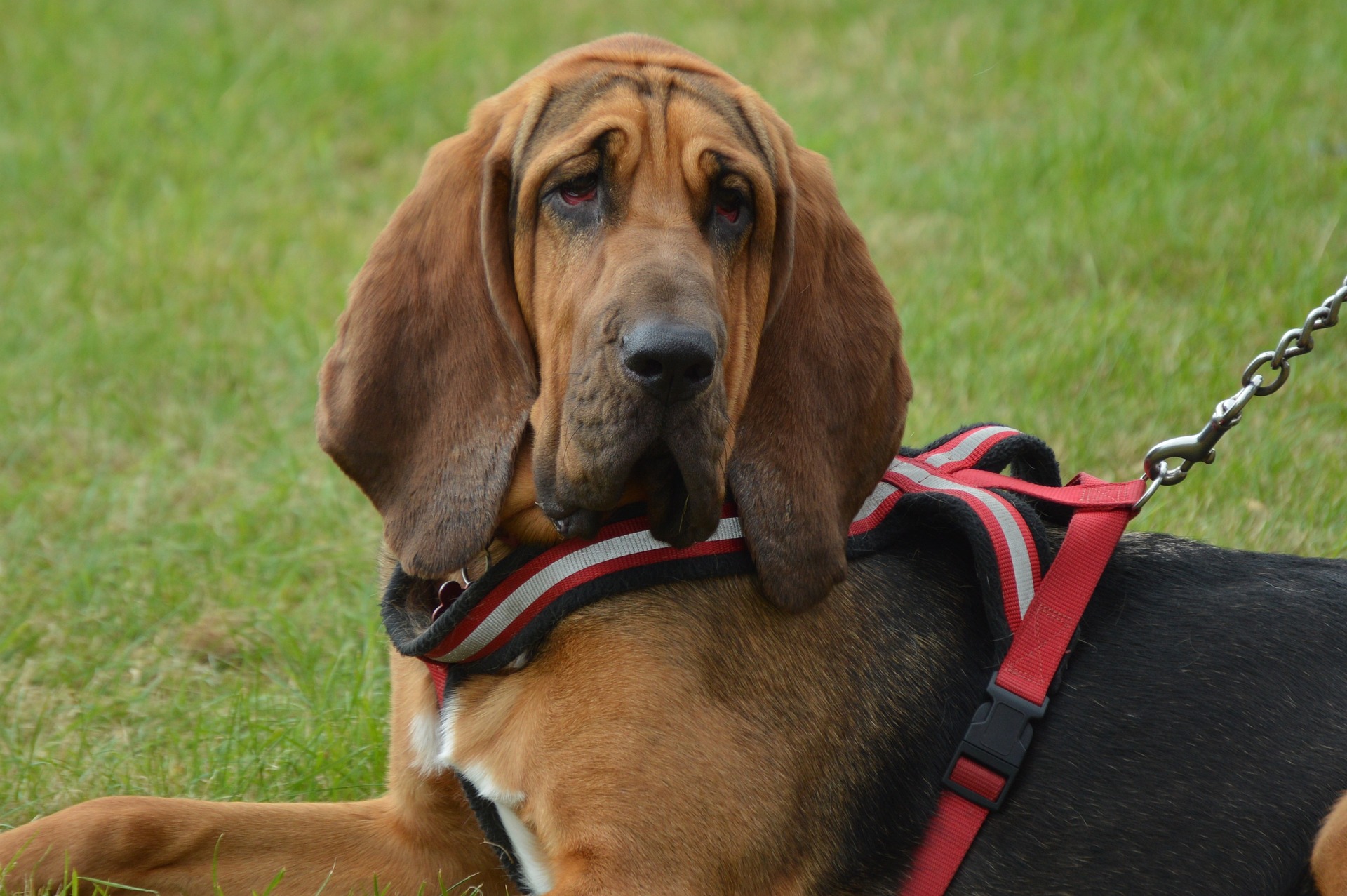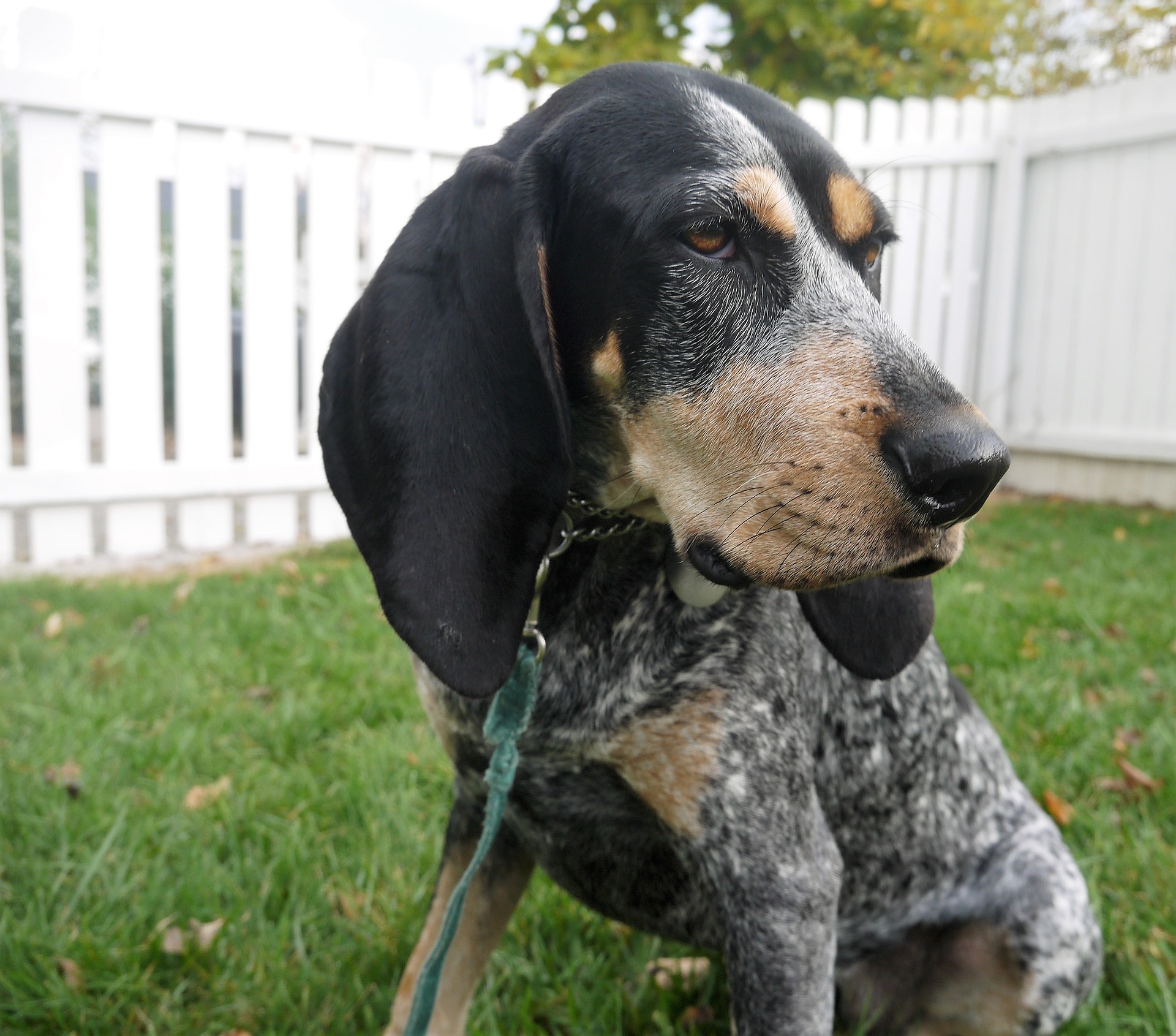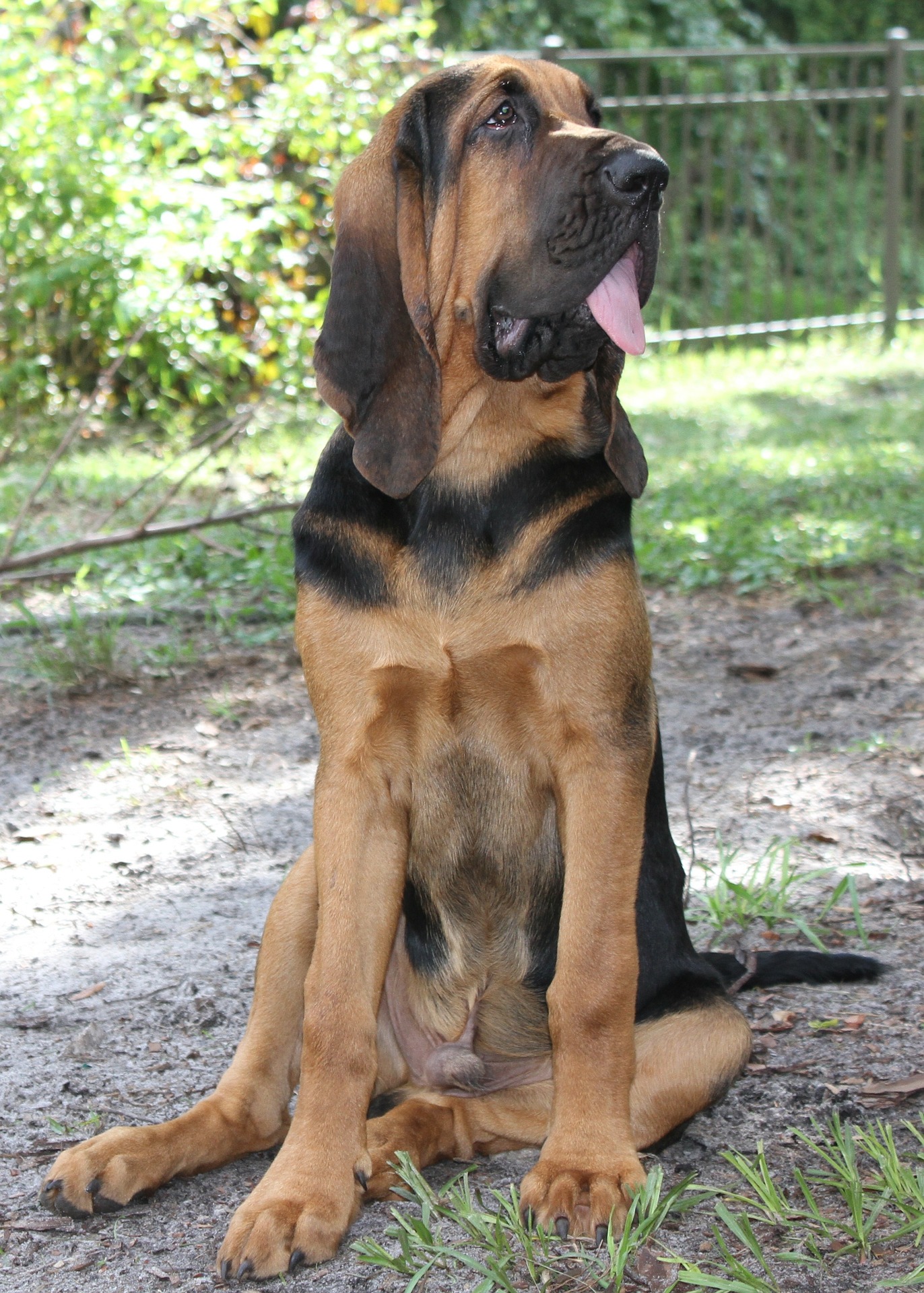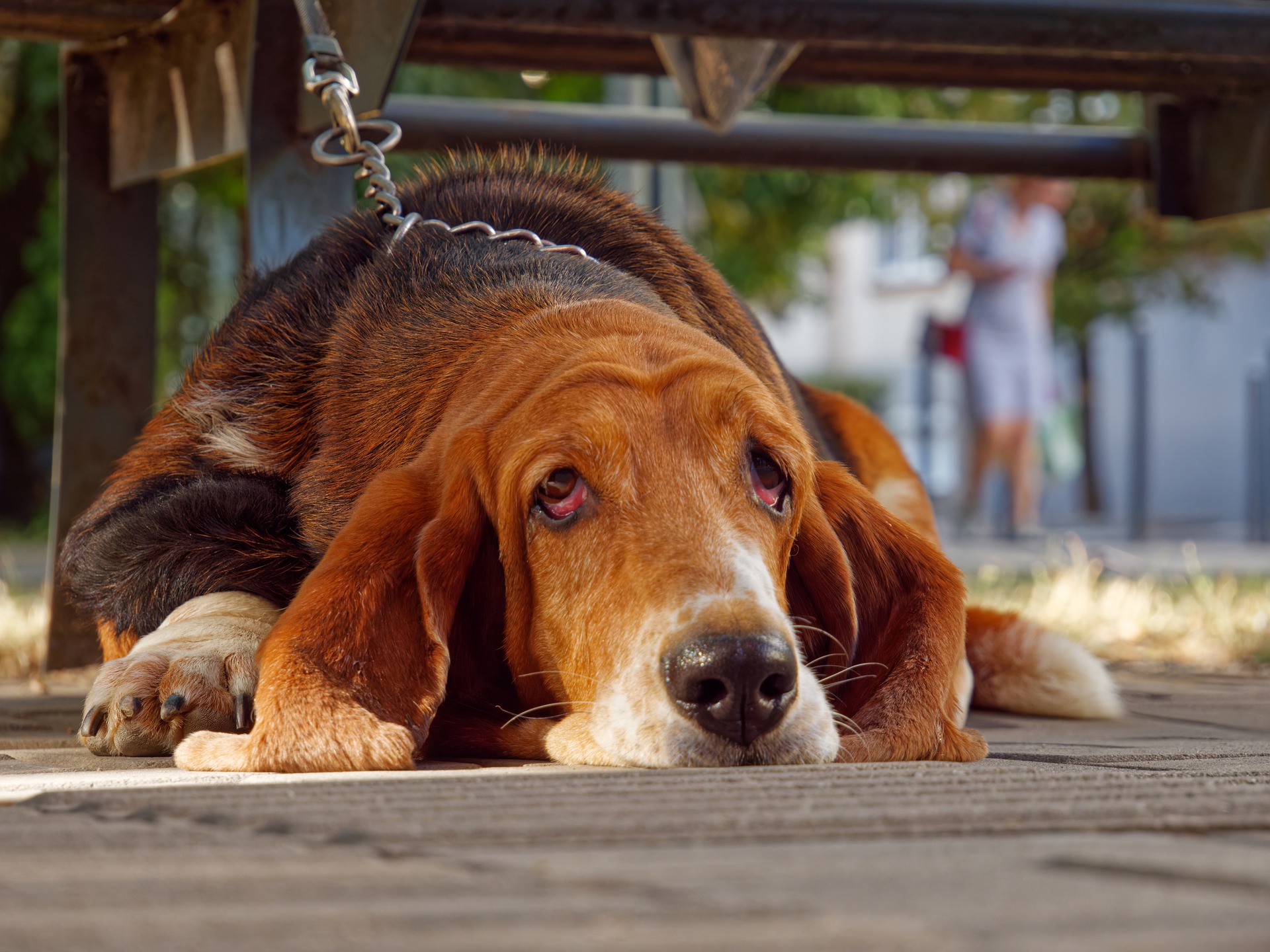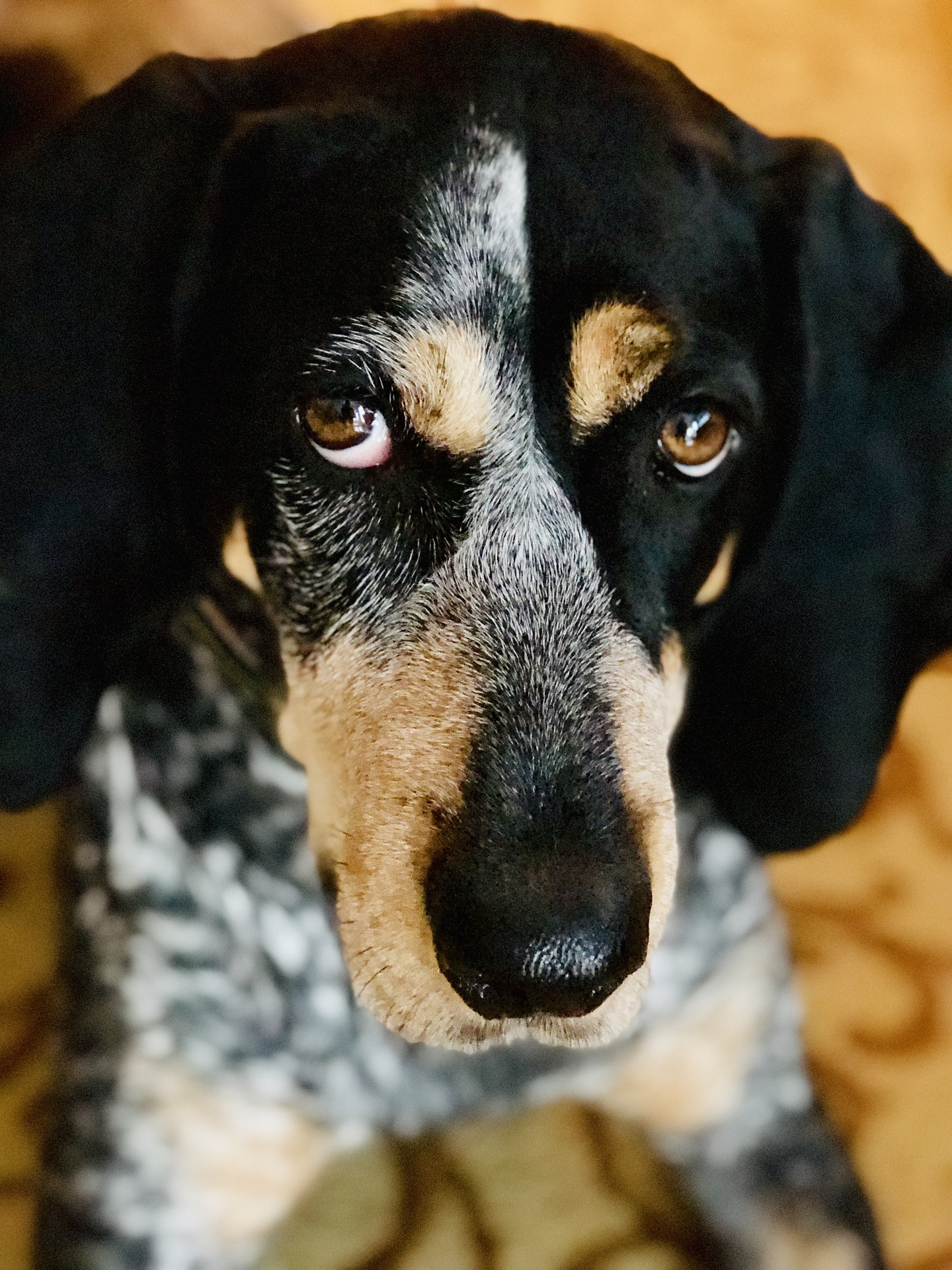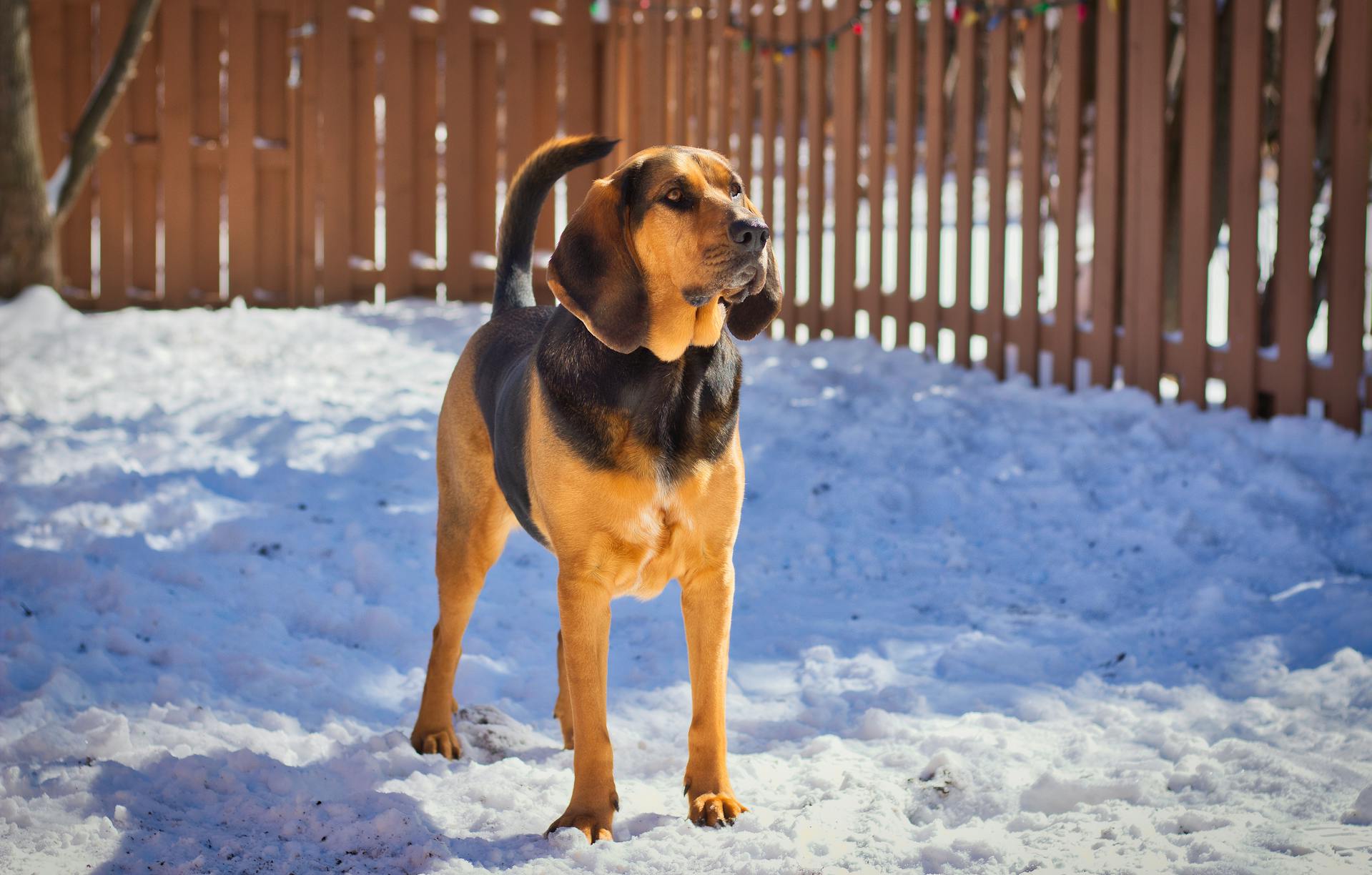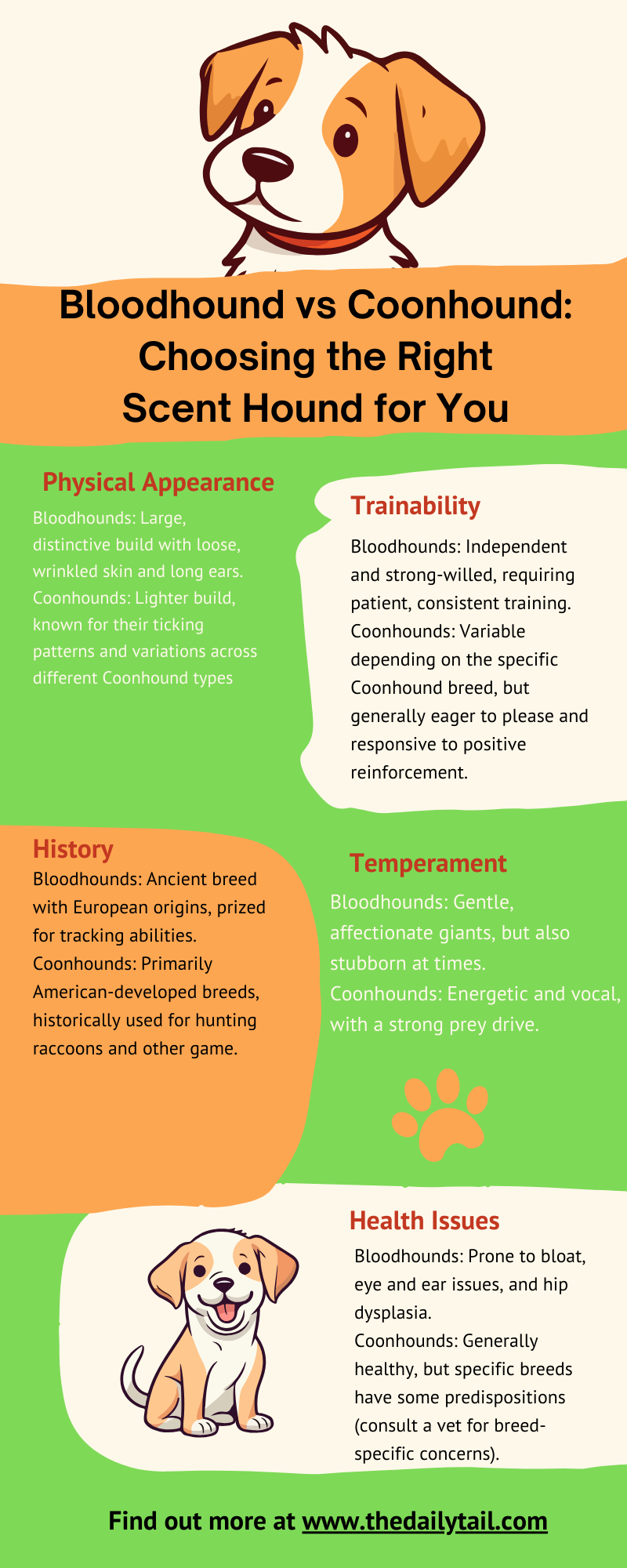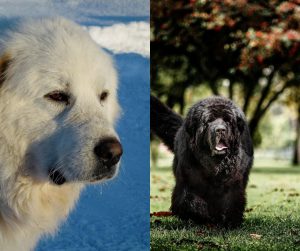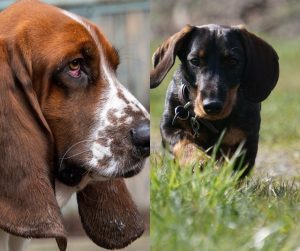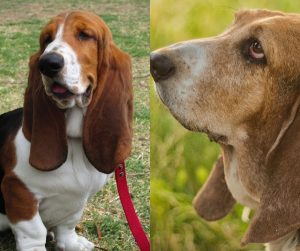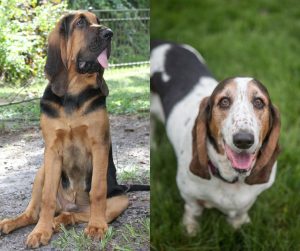As a seasoned dog owner, I’ve always held a special place in my heart for the scent hound breeds. From the floppy ears to the soulful eyes to their unmatched ability to follow a trail, there’s something captivating about them. But for those considering adding a hound to their family, questions arise – particularly when it comes to the iconic Bloodhound and the diverse group of Coonhounds.
These magnificent breeds share a love of sniffing out adventure, but their similarities can sometimes disguise key differences. Let’s dive into the fascinating world of Bloodhounds and Coonhounds, unraveling their distinctive traits to help you find the perfect furry companion.
When deciding between the affectionate Bloodhound and the adaptable Coonhound, potential dog owners often weigh their differing characteristics to find the ideal companion.
Bloodhounds have set the benchmark for tracking and possess an exceptional sense of smell, making them great for search and rescue operations. With their large stature, they require adequate space to roam and ample exercise to stay physically and mentally stimulated.
On the other hand, the Coonhound’s agility and varied lineage—boasting several types such as the Black and Tan Coonhound, Redbone Coonhound, and others—offer a diverse range of traits to suit different hunting and tracking needs.
They’re particularly adept at hunting smaller game like raccoons and are skilled at navigating rugged terrain.
Each dog breed brings its own unique history and personality to the table, which can deeply influence their role in a family or work environment and their interaction with other pets and children. With that in mind, I want to you through the comparison between Bloodhound vs Coonhound dog breed.
Key Takeaways
- Bloodhounds excel in tracking due to their superior sense of smell
- Coonhounds are agile hunters that perform well in varied terrain
- Both breeds require understanding of their temperament and care needs when considering as family pets
History and Origins
When one looks at the history of the Bloodhound and the Coonhound, it’s like reading two different tales from dog breed history. Each breed has an intriguing past that can be traced back to different lands and times.
Bloodhound History
The story of the Bloodhound begins in Medieval France. They’re a breed with an ancient lineage that can be traced back to around 1000 AD, with some records suggesting their presence in Britain around 1300.
Originating from the bloodlines curated by the monks of St Hubert’s Abbey, Bloodhounds were once companions to the aristocracy, lauded for their keen sense of smell—a trait that has remained their hallmark. Because of their origins, they were was once called St Hubert hound dog.
We can also say that the Bloodhound dog breed is a close cousin to the Basset Hound. They look similarly and share some origins and genetics.
Coonhound Development in the United States
Fast forward to the United States, the Coonhound emerges as a distinct entity in the canine world.
Although not as ancient as the Bloodhound, the Coonhound has a mixed heritage, combining the skills of various European hunting dogs with the American Foxhound to create a new dog breed.
The Coonhound is a member of the hound group. The American type of hunting dog was developed for hunting raccoons, but also feral pigs, bobcats, bears, and cougars. Nowadays, the term is somewhat similar to how we use the term American Pit Bull Terrier.
Coonhound is an umbrella term that includes representative species like Bluetick Coonhound, Treeing Walker Coonhound, Redbone Coonhound, Black and Tan Coonhound, Plott Hound, and American English Coonhound.
Each variety, whether it’s the Black and Tan, Bluetick, or Redbone, carries the shared trait of exceptional tracking ability.
Physical Traits and Appearance
Bloodhounds and Coonhounds are distinctive in their looks and build, each breed displaying unique physical characteristics that set them apart. From the size of their frames to the color of their coats, these dogs possess defining features sure to catch the eye of any dog enthusiast.
Comparing Size and Build
Bloodhounds are known for their large stature, with males often weighing between 90 to 110 pounds and females slightly lighter at 80 to 100 pounds.
Their build is sturdy and robust, fit for endurance.
Coonhounds, on the other hand, are leaner and more versatile in size. Depending on the variety, like the Bluetick or Redbone, they can range significantly in weight. Generally, they fall within a lighter weight range than their Bloodhound counterparts, making them appear more agile.
Coat Color and Grooming Needs
When it comes to coat color, Bloodhounds typically exhibit shades of black and tan, liver and tan, or red.
They have a short, dense coat that requires regular brushing to minimize shedding and maintain its neat appearance.
Coonhounds also share similar coat colors but may have more patterns and markings.
Their grooming needs are comparable, with a short to medium-length coat that benefits from routine care to keep them looking their best and to control shedding.
Distinctive Features
One cannot discuss these breeds without mentioning the long, floppy ears both are known for. These aren’t just for show; they help to waft scents towards the nose, aiding in their tracking abilities.
Distinctive features of Bloodhounds include deep-set eyes and wrinkled skin, particularly around the face, giving them a sober, wise expression.
Coonhounds have a sharper look, with ears that may be slightly less droopy than those of the Bloodhound but no less characteristic of the scent-hound family.
Temperament and Personality
When considering a Bloodhound vs Coonhound, it’s essential to understand that both breeds exhibit a unique blend of temperament and personality traits which can influence their behavior and interactions with family, particularly children.
Both are generally friendly, affectionate companions, yet they bring their distinctive characteristics to the table.
Training and socialization are crucial aspects of their upbringing, consistently shaping their behavior as they mature.
Behavioral Characteristics
Bloodhounds are known for their exceptional sense of smell and calm demeanor.
This scent hound dog breed can be stubborn at times, requiring patience during dog training. Their strong tracking instinct may sometimes override obedience.
Coonhounds also possess a strong scent drive, but they tend to be more versatile and energetic, requiring ample exercise to satisfy their high activity levels.
Both breeds are intelligent, yet their independent nature can make them seem aloof when focused on a task.
Interaction with Family and Children
As family pets, Bloodhounds and Coonhounds are generally loyal and affectionate.
The Bloodhound is gentler, often showing a patient and tolerant side with children.
Coonhounds, with their variety of breeds, can range from outgoing to reserved, but typically, they are good-natured and enjoy being part of the family.
Supervision is advised when either breed interacts with very small children, primarily to ensure gentle play due to their sizes and exuberant personalities.
Training and Socialization
Training a Bloodhound or Coonhound requires a consistent, respectful approach.
Both respond well to positive reinforcement techniques such as treats and praise.
Early socialization is imperative — exposing them to diverse environments, people, and other animals helps develop a well-rounded pet.
Despite their independent traits, regular training can harness their intelligence and scent-tracking abilities in a productive way.
It’s not just about obedience; it’s about forming an understanding and trusting relationship.
Exercise and Activity Levels
Both Bloodhounds and Coonhounds have a storied past as hunting dogs, which means they come with a set of exercise and energy level needs that are vital for their well-being.
Daily Exercise Needs
Bloodhounds are renowned for their stamina, able to trail scents for hours without a sign of fatigue.
They require significant daily exercise—long walks or a chance to run in a secure area are essential.
Engaging them in activities like tracking can provide both mental and physical stimulation. Without this, they may become bored and possibly destructive.
- Coonhounds, on the other hand, are also active but are more adaptable in their energy outlets
- A moderate to long walk coupled with playtime often suffices. They excel in activities such as hiking and running alongside their owners, turning exercise into a bonding opportunity
Suitability for Active Families
Bloodhounds and Coonhounds both make excellent companions for active families. Their need for exercise aligns well with families who enjoy outdoor activities.
- Bloodhounds: Although gentle, their size and strength mean they’re best suited for families with larger spaces and the capability to handle an exuberant dog during walks and play
- Coonhounds: Known for being versatile, they can fit well with various family dynamics, including those with children, as long as their exercise needs are met
Health and Care
When choosing between a Bloodhound and a Coonhound, their health and care are vital components to consider. Each breed has specific needs that, if met, can lead to a happy and healthy life.
Common Health Issues
Bloodhounds are prone to certain health concerns that potential owners should be mindful of.
Notably, they often face hip dysplasia, a condition where the hip joint does not form properly, and it can lead to pain and mobility issues.
These large canines also are susceptible to bloat, which is a life-threatening condition involving the stomach. It requires immediate veterinary attention.
Ear infections can be quite common, too, given their long, droopy ears that can trap moisture.
Coonhounds, on the other hand, tend to be quite resilient but are not without their health risks.
They can experience hip dysplasia as well. Hypothyroidism, a disorder where the thyroid gland doesn’t produce enough thyroid hormone, is another condition to watch for in Coonhounds.
Care Requirements and Lifespan
Bloodhound:
- Lifespan: 10–12 years
- Weight: On average, Bloodhounds weigh between 80 to 110 pounds
- Grooming: Their grooming needs are moderate but consistent; brushing a couple of times a week helps manage shedding and skin health
- Exercise Needs: These dogs require regular exercise to maintain their health and prevent boredom
- Drool: They are known for drooling, which some pet owners may need to manage with regular cleaning
Coonhound:
- Lifespan: 10–12 years
- Weight: They are usually lighter than bloodhounds, with weights ranging from 50 to 75 pounds
- Grooming: Coonhounds have a short, manageable coat that makes grooming a breeze, needing only occasional brushing
- Exercise Needs: These energetic dogs need plenty of exercise to satisfy their high energy levels
- Drool: Less of an issue in Coonhounds compared to Bloodhounds
Hunting and Tracking Skills
When it comes to the revered art of scenting, Bloodhounds and Coonhounds stand out with their supernaturally keen noses.
Let’s dig into how they use their sniffers to track and what really sets them apart in the hunting grounds.
Scenting Abilities and Search Operations
Bloodhounds:
- Sense of Smell: Their olfactory prowess is unmatched, boasting over 300 million scent receptors
- Search Operations: Excelling in search and rescue, they can follow a scent trail for miles, making them indispensable in finding lost people
Coonhounds:
- Scenting Abilities: Adept at picking up faint scents, they specialize in nocturnal hunts
- They’re particularly known for their skill in treeing raccoons, which is the act of chasing prey up a tree and holding it there
The Treeing Walker Coonhound, a specific variety, is noted for its impressive ability to locate and tree quarry.
Hunting Techniques and Prey Preferences
Bloodhounds traditionally hunted deer and wild boar, but have largely transitioned to a peaceful role in modern search and rescue efforts.
These gentle giants may have a hefty build, but their tracking skills are utilized more for finding people than hunting.
On the flip side, Coonhounds flex their tracking skills in more traditional hunting, with raccoons being their primary target.
They use their acute sense of smell to follow the raccoon’s trail and their loud barks to signal hunters from beneath treed prey.
Living With a Hound Breed
When adopting a hound breed, whether a Bloodhound, Coonhound, or any other, it’s crucial to understand they are not just pets but companions with specific needs and preferences that thrive in suitable environments.
Understanding Their Unique Needs
Hound breeds stem from a storied lineage of hunting dogs, known for their high energy levels and sharp olfactory senses.
They require regular exercise and interactive play to satiate their instinctual urges.
A hound’s day should include a blend of physical activity and mental stimulation. These dogs are patient and laid-back when their needs are met, making them excellent companions.
Their need for social interaction is distinct. Hounds are inherently social animals that crave companionship, both human and canine. Ensuring they receive this stimulation is key to their emotional well-being.
In terms of trainability, hound breeds are responsive; however, they do best with consistent and patient training methods that recognize their independent nature.
Finding the Right Environment
The ideal environment for a hound breed adjusts according to their preferences.
For instance, a spacious, fenced yard can be a haven for a Bloodhound’s explorations, whereas a Coonhound might require safe, open spaces to follow scents and indulge in its tracking habits.
Nevertheless, these breeds are adaptable and can thrive in an apartment setting, provided their exercise and stimulation needs are met.
A prospective pet owner living in an apartment must be willing to dedicate ample time daily to outdoor activities. A hound’s energy level demands commitment to keep them healthy and content in a more confined space.
Creating a pet-friendly home means being tolerant of the quirks that come with hound breeds—their frequent vocalizations, the occasional stubbornness, and their desire for exploration and company.
Orientation towards a routine that caters to these traits will ensure harmonious living with a hound breed.
Choosing Between Bloodhound and Coonhound
When faced with the decision of choosing between a Bloodhound and a Coonhound, prospective pet owners should consider the breeds’ differences in temperament and purpose. These aspects are crucial for ensuring the chosen breed aligns with their lifestyle and expectations.
Identifying Your Preferences
Lifestyle Compatibility:
If someone values a gentle and friendly family companion who is patient and loving, they might lean towards the Bloodhound.
These dogs are known for their even temper and can be particularly good with children. They’re also valued in law enforcement for their keen tracking abilities.
On the flip side, those looking for a more independent and versatile canine might find a Coonhound appealing.
Coonhounds are typically tolerant and stubborn, suitable for those who appreciate a dog with a mind of its own.
Activity Level:
- Bloodhounds:
- Require ample exercise
- Need mental stimulation to prevent boredom
- Coonhounds:
- Thrive on variety and activity
- Can be more adaptable to different types of outdoor adventures
Space Considerations:
In terms of space, Bloodhounds are larger, and they tend to eat more, which should be considered in both the size of living space and the budget for food.
The Coonhound, being slightly smaller, might be more suited to a variety of living conditions.
Appearance Preferences:
- Bloodhounds: Heavier build and tend to have wrinkled skin, especially on the neck
- Coonhounds: Display a wider variety of colors and generally lack the wrinkled appearance
Purpose of the Dog:
- Bloodhounds: Excel in tracking and are often used in search and rescue or law enforcement
- Coonhounds: While also good trackers, they are more commonly associated with hunting and may have a stronger prey drive

